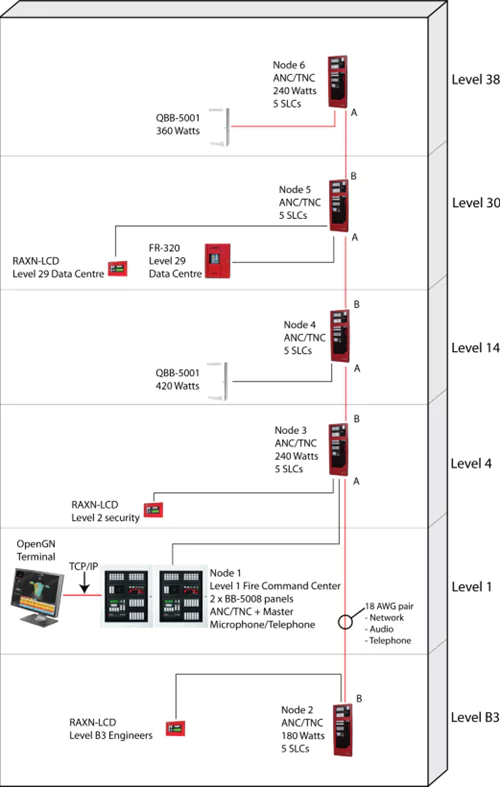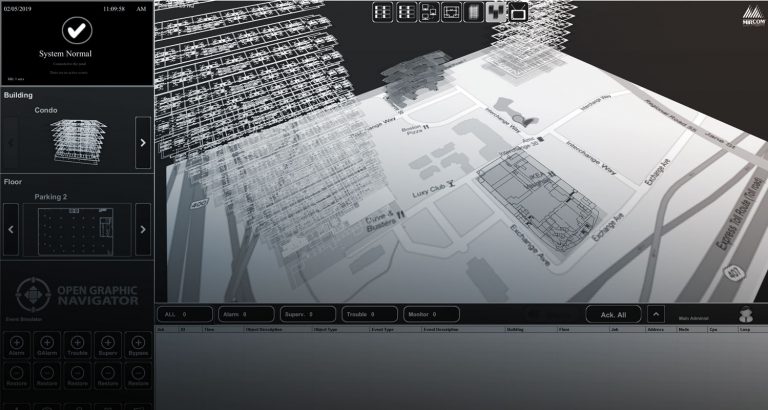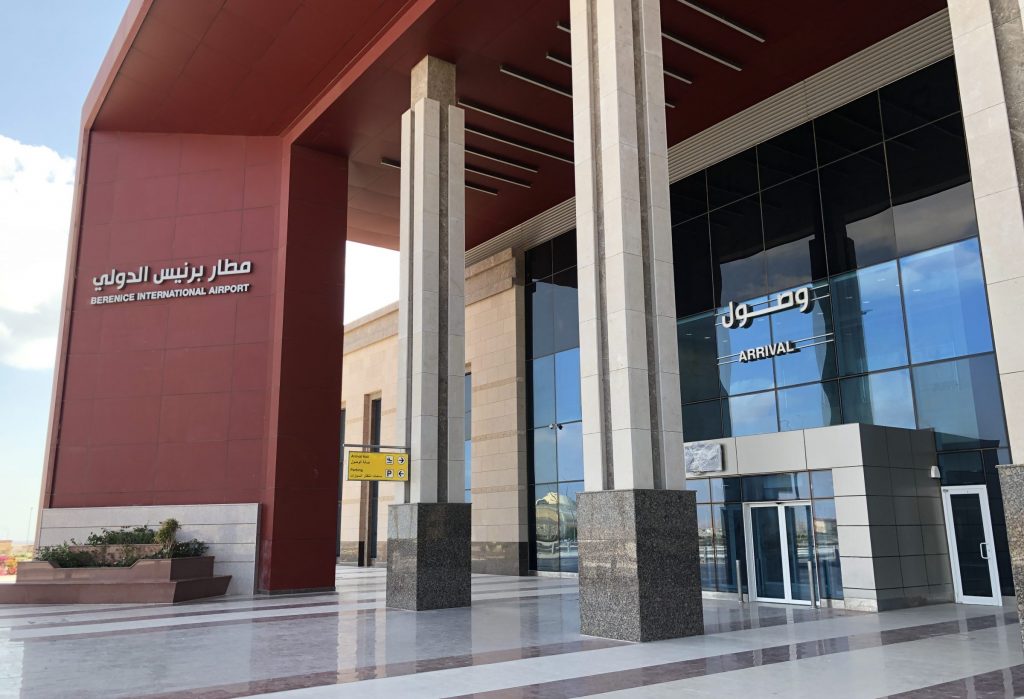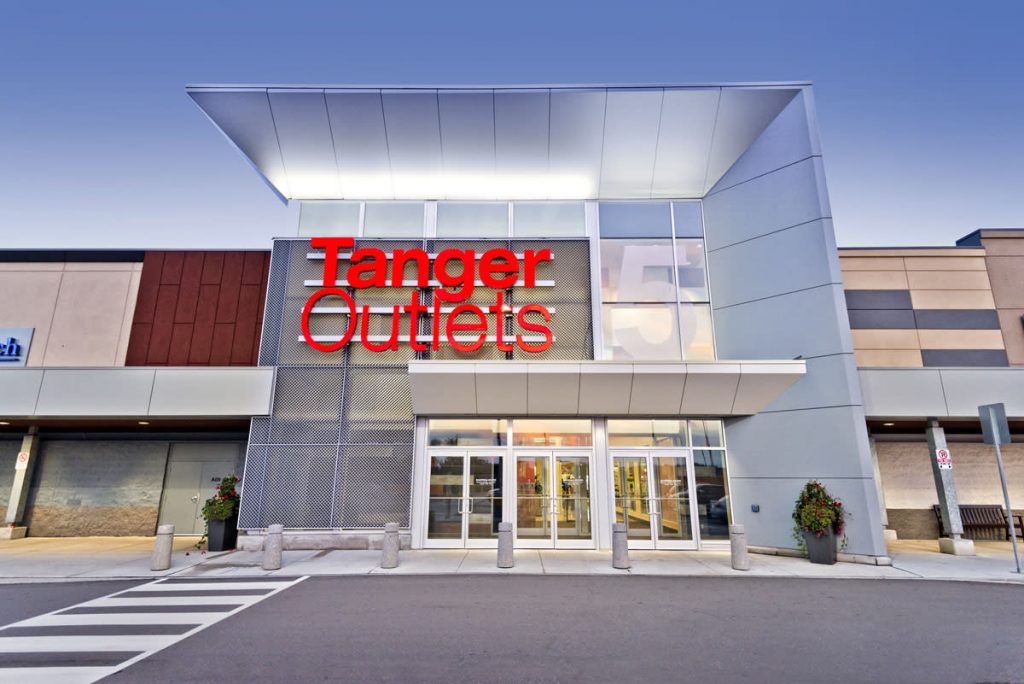BACKGROUND
The CenterPoint Energy Tower is a 47-story mixed use skyscraper located in downtown Houston, Texas. The building is considered to be a Houston landmark, distinguished by a six– story extension featuring a large hole for visual interest. The building also features a basement with underground tunnels leading to other high rise buildings, a full cafeteria-style dining room, a shopping area, a loading dock, and three floors of underground parking garage space.
This Case Study examines the retrofit of the building’s fire alarm and communications system and the design considerations fundamental to providing time-sensitive intelligible notifications in response to a fire or emergency situation.

PROJECT OVERVIEW
As part of the overall restructuring of the CenterPoint Tower, it was time for a fire alarm and communications upgrade as well. The CenterPoint team required a retrofit of a new fire alarm network and mass notification system (MNS) to complement the major restructuring and restoration of the infrastructure of the building. The solution had to be designed to provide MNS for emergency and fire communications to all building occupants and personnel.
The building’s original competitor system reached the end of its life due to chip failure. Mircom branded solutions were selected for replacement due to ease of use, affordability, and strong reputation.
SPECIFICATIONS OF THE RETROFIT REQUIRED THE FOLLOWING:
- An intelligent fire control unit with networking and distributed audio capability
- Advanced audio sequencing with real time automatic pre-recorded messaging during alarm conditions
- Single-key automatic “page- to-evac” live voice paging to support MNS requirements
- Integration with agent releasing equipment for protection of high priority server and computer rooms
- Real time graphical annunciation of the fire control system to assist with maintenance and emergency response personnel
OTHER REQUIREMENTS:
Nodes
The project required 6 network control units (nodes).
Communications
The project required a full emergency communication package with a microphone and speaker selects, in addition to a firefighter’s telephone with the select feature on each floor.
LCD Annunciators
The project required three remote LCD annunciators.
Other
There were 257 duct detectors and approximately 2000 smoke

The team completed the project in a systematic manner, going floor by floor starting from the top, and verifying along the way. This type of approach ensured minimal disturbance to the normal workflow of the building and eliminated the need for fire watch, saving time and money.
THE PROJECT WAS COMPLETED IN THE FOLLOWING SEQUENCE OF STEPS:
1. Installed the FleX-Net MNS transponder units side by side with the existing fire alarm control units:
As this retrofit was considered a one-to-one replacement, an FX-MNS transponder was installed side-by-side with each of the pre- existing fire alarm transponder units. At this time, the building was still monitored 100% by the pre-existing fire alarm system.
2. Established a network communication bus utilizing peer-to-peer protocol between the FleX-Net MNS transponder units:
Each FX-MNS transponder unit, with the addition of the FNC-2000 Network card, was networked utilizing the pre-existing fire alarm cable wired in an A-to-B style network fashion. Non-latchable relays/contacts between the FleX-Net and existing fire alarm units were installed to ensure event propagation between panels (because field devices and output signals were monitored by the existing fire alarm units at the time).
3. Transferred all devices floor by floor from the original fire alarm system to the Flex-Net MNS transponder units:
Starting from the top floor, the team worked to transfer the monitoring of field devices from the original fire alarm system to the FX-MNS transponders. Each floor was verified to ensure accurate programming before moving to the next floor. At this time, all audio was driven by the existing fire alarm system.
4. Transferred full audio capabilities from the existing system over to the FleX-Net MNS transponder units
Full audio and telephone capabilities are achieved with the installation of the ANC-5000 and TNC-5000 control modules at each FX-MNS transponder. Similar to the FNC-2000, an audio bus was wired in an A-to-B style network between each unit to support audio and telephone communication between transponders. Pre-existing wires were used to support the audio and telephone bus; however, FleX-Net is capable of compressing this data through the network bus if necessary.
5. Removal of the existing fire alarm system
With 100% of all monitoring devices now transferred to the FX-MNS units and an established audio and telephone network bus between units, the existing fire alarm system was removed.
Value added: Open graphic navigator
- Open GN is designed to work in sync with the MGC Fire Detection and Mass Notification Configurator Software. This allows a seamless and effortless means for importing the actual on-site configuration into the Open GN Once imported into the Open GN Database, all device points are available for a simple “drag & drop” placement and will transition from RED to GREEN to easily distinguish between placed and unplaced devices. Unique device tags for each device point are included
as well. This simple feature became invaluable for the team, allowing them to effortlessly place all 2000+ device points. - A dedicated PC terminal to operate the Open GN application was mounted within the BB-5008 Fire Alarm Control panel with a custom fitted 24” Touchscreen
- AutoCAD .dwg files of the Centre- Point Energy Tower were converted into SVG type files and imported into the Open Graphic Navigator SVG files were used to ensure clean, sharp images when displayed in a 3D or 2D point of view.
- Proprietary XML Adapter Software developed by Mircom allows for consistent communication protocol between the FleX-Net Fire Alarm Network and the Open Graphic Navigator Software through a TCP/IP connection. The XML Adapter is capable of supporting multiple Open GN applications as well as networking multiple FleX-Net applications over a TCP/IP network.


MIRCOM SOLUTIONS USED
FLEX-NET PHASE II NETWORK FIRE ALARM & AUDIO CONTROL PANEL SOLUTION
Mircom’s FleX-Net Series Network Fire Alarm Control Panels offer modular components to meet a wide variety of applications. Designed for peer-to-peer network communications, the FleX-Net Series allows for a maximum of 63 nodes, while providing reliability, flexibility and expandability.
Features and Benefits:
- Integrated, multi-modal solution
- Robust stable network topology with redundant survivability
- Real time multi-lingual/multi-audience messaging capability
- Support for framing warning messages customized to CenterPoint Tower
- Reduction of costs and operational complexity by eliminating multiple custom software interfaces to warning sources and dissemination systems.
MIRCOM™ FR-320 SERIES
Mircom’s FR-320 is a dual releasing control panel that is field configurable for use on Deluge Sprinkler Systems, Pre-action Sprinkler Systems and Agent Release Systems.
Features and Benefits:
- Listed to UL 864, 9th edition
- Field configurable to operate with a Deluge
- Sprinkler System, a Pre-action Sprinkler System and an Agent Release System
- Six Class B (Style B) Input Circuits
Input Circuits Five & Six can be configured as Manual Release Input, Abort Input or Abort/Manual Release Combination Input depending on the Mode of Operation selected.
MIRCOM OPEN GRAPHIC NAVIGATOR (OPEN GN)
Mircom’s Open GN is an award winning and powerful 3D graphics based building systems monitoring tool that gives unprecedented visualization of on- premise emergencies. Firefighters and first responders rely on this tactical display to instantly assess dangers and threats in a facility compromised by terrorists or weather emergencies. Open GN creates safer, more intelligent buildings everywhere.
The Open GN system installed at CenterPoint includes a touch screen monitor custom fitted into a BB-5008 enclosure with the FleX-Net main panel.
Features and Benefits:
- Building ready monitoring control system with full software management in a user friendly graphical enabled interface Provides easy configuration and customization of alarm devices Customizable fire annunciation graphical icons to provide CenterPoint specific site representation
- Custom alarm and system status messaging instantly inform CenterPoint building administrators of events and alarms
- Custom color graphical icons depict up to 500,000 addressable devices & extensive event logging of up to 500,000 events
- Extensive event logging up to 500,000 events with status notations for report customization
RESULTS OF THE PROJECT:
The Mircom engineered solution delivered efficient building integration, stability and connectivity for the CenterPoint tower. The operations of the mixed-use building were never disrupted throughout the term of the project, ensuring business continuity.
DELIVERED BY:
The Mircom Group of Companies and Micronet Technology, Inc. worked as strategic partners with the CenterPoint team. The total project duration lasted 10 months and was completed by a small team of four people.




